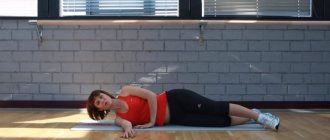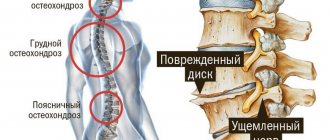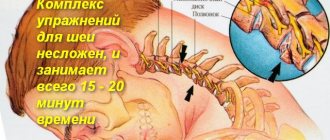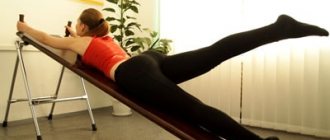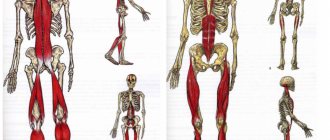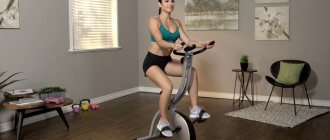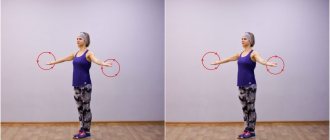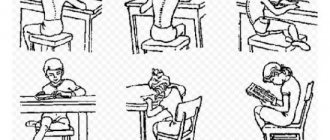Poor posture can be called a feature of modern society. During routine medical examinations, doctors record their presence even in children attending kindergarten. Among schoolchildren, the percentage of postural pathologies is even higher, and among the adult population, not only the actual curvatures are diagnosed, but also their consequences - chronic diseases of the spine.
It is hardly advisable to talk about the reasons for its occurrence; they are known: low mobility, improper load distribution, sitting for many hours at the computer and passion for other benefits of civilization. It’s more important to learn how to straighten your spine and get serious about it. Right at home.
Competent approach
There are no pills that straighten your posture, no injections, maybe a trip to the doctor is not necessary? The doctor will not control how you distribute the load, perform therapeutic exercises, and monitor your posture. It’s still not worth canceling your trip to the doctor, because only he will be able to accurately determine the type of postural disorder, its degree, and select an individual rehabilitation program for you.
We answer the question which doctor deals with posture problems:
- Orthopedist;
- Neurologist;
- Vertebrologist;
- Chiropractor;
- Kinesiotherapist;
- Physiotherapy doctor;
- Physiotherapist.
The list is sufficient, and you should specifically decide on your choice. It is optimal to make an appointment with an orthopedist or neurologist first - these specialists will refer you for an examination, diagnose the pathology and determine further tactics of behavior.
In a regular clinic, you will receive a referral to a physical therapy room, where you will be shown special exercises that you can perform at home. Based on the X-ray examination data, the doctor will be able to answer the question whether it is possible to straighten your spine or whether it will be possible to correct the poor posture only partially.
It is physiologically determined that the growth of the spine ends at 25 years of age. Therefore, any postural disorders can be successfully corrected before this age. If a patient asks whether it is possible to straighten the spine at 30 years old, the answer will most likely be no.
However, by doing exercises regularly, you can significantly strengthen the muscle corset, which is important for maintaining posture. With regular exercise, the erector spinae muscle is toned, maintaining the spinal column in the correct position.
Methods of reduction and which doctor to contact?
There is a common phrase among people: “a vertebra has fallen out.” Of course, there can be no loss, since such a situation would most likely lead to complete paralysis or death. There is a more scientific term - “vertebral displacement”. Most often, this problem occurs in the lumbar region, rarely in the cervical region, and almost never in the thoracic region. In this case, the vertebrae need to be realigned. Carrying out such a procedure at home is dangerous, it can only worsen the situation. “Proven” recipes from friends and relatives can cause serious back problems, so it is better to consult a doctor and undergo a full examination. Who is treating this problem? A traumatologist or chiropractor can realign the vertebrae. You can also contact a neurologist, surgeon, vertebrologist or orthopedist. But sometimes back pain can be the result not of a dysfunction of the spine, but of muscle spasm. The muscles tighten and retain blood. In this case, you will need the help of a massage therapist. In addition to massage, the doctor may prescribe the following conservative methods for realigning the spine:
- physiotherapy;
- exercises on special simulators;
- wearing a corset.
If none of the methods help, then the last solution is surgery. In some cases, only surgery can return a person to their normal lifestyle.
Traumatologist
Displacement of the vertebrae occurs for various reasons. These could be injuries, heavy physical labor or various diseases. When sharp pain occurs, you should immediately go to the emergency room, where a traumatologist will send the patient for an X-ray to determine the location of the damaged vertebra. An MRI or CT scan may be required in the future. It is quite difficult to realign the spine, and the specialist who undertakes this procedure must have information about all indications and contraindications, and ideally know anatomy and physiology.
The spine is not only the basis of the skeleton, it has a close connection with the internal organs.
For example, the heart corresponds to vertebrae 2, 3 and 4, and if at least one of them is displaced, a serious illness can occur. In the future, you will need conservative treatment, taking muscle relaxants and painkillers. The patient needs rest and limitation of physical activity. Swimming, acupuncture, radon baths and other physiotherapeutic procedures also have a beneficial effect on the spine. A traumatologist can only straighten the vertebra, but then you need to be treated by an orthopedist or surgeon.
Chiropractor
All manual therapy techniques for realigning the cervical or lumbar vertebrae are divided into diagnostic and therapeutic. For diagnosis, X-rays or MRIs are used, which show a clear localization of the displaced vertebra. Treatment methods are also divided into several groups. Each of the techniques has its own technique and depth of penetration, but all of them are mainly aimed at relieving muscle tension. The spasmed muscles relax, and thus the doctor gains access to the desired vertebra. A chiropractor can straighten the spine using the following techniques:
- stretching;
- twisting;
- compression.
The reduction continues over several sessions, as this process is very delicate. But a truly qualified specialist can straighten the neck with one precise movement. This manipulation is accompanied by a crunching sound and is quite painful, but it gives an instant effect. This important procedure should be entrusted to a truly knowledgeable chiropractor, as serious complications can arise if it is performed incorrectly. Also, the technique of treatment sessions depends on the age of the patient.
If a young person can endure all manipulations without problems, then in old age therapy should be carried out with the utmost caution
Main types of violations
Postural disorders occur in any part of the spine. The leader in the number of pathologies is the thoracic region, where scoliosis (lateral curvature) is most often observed. A less characteristic pathology is pathological kyphosis.
In the cervical and lumbar region, changes in physiological lordosis may be observed - flattening, pathological deflection. The phenomena of scoliosis in these areas also occur, but not as often as in the thoracic vertebrae.
The cervical region deserves special attention. If a disorder is observed in this area, it should under no circumstances be treated independently. The main vessels and nerves pass along the cervical vertebrae, providing nutrition and blood supply to the brain; with inept manipulations by home-grown massage therapists and too active loads, changes in the cervical region are fraught with neurological diseases. Now let's move on to practical methods.
Symptoms of displacement
The nature of the manifestation of symptoms depends on the degree of displacement and its location. However, not all signs may appear simultaneously and immediately after damage, which significantly complicates determining the cause of the illness. Some symptoms are characteristic of other spinal diseases, and in the absence of experience, it is not always possible to recognize the displacement.
Symptoms of vertebral displacement
| Spine department | Characteristic signs |
| Cervical | Symptoms usually appear quickly and quite severely. Tilts and turns of the head become difficult, and a crunching sound is heard in the neck when moving. Migraines, tinnitus, dizziness and nausea are common. There may be numbness in the tongue and throat, fingers, and occasional slight tingling in the upper extremities. |
| Chest | Symptoms are mild and may appear weeks and months after displacement. A dull pain is felt between the shoulder blades and in the chest, which can intensify when lifting heavy objects and moving the arms to the sides, radiating to the lower back, lower and upper extremities. There is also stiffness in the thoracic region in the morning, muscle spasms in the back, shortness of breath, general weakness, and a burning sensation in the chest. |
| Lumbar | In most cases, symptoms appear immediately and are severe. There are lumbagos in the lower back and pelvic region, sharp pain when moving the body, sciatica, and radiculitis. The pain radiates to the lower extremities, the toes go numb, a tingling or burning sensation, and muscle spasms appear. |
In cases of minor displacement, it often happens that the pain syndrome disappears on its own, but as soon as you unsuccessfully bend over or lift something heavy, it appears with renewed vigor. Sometimes people suffer from nagging back pain for years, not realizing that it is caused by misalignment of the vertebrae.
Straightening the back with scoliosis
Scoliosis is the most common type of spinal curvature. In this case, the bulges and bends are directed to the sides. Treating scoliosis is a difficult task, especially in adults. After all, children's bones and joints are more elastic than those of adults. But you shouldn’t despair: regular exercise will help everyone, the main thing is to be patient and persistent.
Creating a “counterbend”
How to straighten the spine with scoliosis? First of all, you need to find out in which direction the convexity of the bend is directed - to the right or to the left. Based on this, we must remember about the disease and create a “counterbend” whenever possible.
For example, for scoliosis, you should adhere to the following recommendations:
- Decide how to sleep to straighten your spine. If you have a right-sided curvature, you need to sleep on your left side; if you have a left-sided curvature, you need to sleep on your right side.
- do exercises to strengthen primarily the muscles of the half of the back opposite the angle of curvature;
- when sitting for a long time, place a book under the buttock on the healthy side or place the leg from the healthy side on the other;
- When walking, lean more on the leg on the healthy side.
Surely you know that there are techniques for traction of the spine. They are performed using different methods - lying on the floor, using a hang on the horizontal bar. But let us remind you that before you straighten your spine on the horizontal bar, you must at least undergo an x-ray. Among the pathologies of the back, there are those in which stretching on the horizontal bar is contraindicated (hernias, for example).
Exercises for beautiful posture
A slouched back begins with the habit of walking with your head down. Following the muscles of the neck, the shoulders relax, and the whole figure becomes hunched. To avoid this, you should try to always keep your head straight and your chin slightly raised. You can train yourself to the correct head position using exercises with a bag:
- Fill a thick canvas bag with sand or regular table salt to make a load weighing 200-300 grams;
- Build a small “obstacle course” in the room from chairs or stacks of books that you will need to carefully walk around;
- Press your back against the wall and place the bag on the top of your head;
- Slowly walk to the opposite end of the room, walking around your improvised labyrinth along the way and trying not to drop the bag;
- Having reached your goal, sit cross-legged against the wall. Then kneel down, and only then rise to your full height;
- Go to a small elevation (stool, ottoman, low sofa), climb onto it, and then go back down, still holding the bag on your head. It is better to repeat this part of the exercise ten to twenty times.
Gymnastics for the spine
Therapeutic gymnastics helps strengthen the back muscles that support the spinal column and helps get rid of scoliosis.
Exercise from the wall
While standing, alternately press down on a vertical, stationary support (such as a wall or cabinet). This exercise tones the muscles on the supporting side. The duration of each technique is 3 seconds. Rest – 1 second. Repeat 10 times. Do at least 5 approaches a day.
Here are 2 more exercises that straighten the spine:
Exercise lying sideways on the floor
Lying on your side, extend your arm forward and bend your lower leg. Then the torso should be tilted forward, and the upper straightened leg should be pulled back. To make the exercise more effective, you can attach a weight to your straight leg. Repeat 5 times.
Exercise lying on your stomach
Strengthening the erector spinae muscle:
- Lie on your stomach face down.
- Extend your arms forward.
- Arch your back until you feel a slight contraction of the muscles (do not arch your neck too much).
- Lower yourself down, touching your chest to the floor.
If the slightest pain occurs while performing the arching, you should stop the exercise immediately. There is also an easier option for arching your back with support. It differs from the described exercise in that you need to place your hands on the floor in front of you and, when bending, rest them on the floor.
How to realign a vertebra
Why do vertebrae become displaced? There is no definite answer, because there are many reasons. Sometimes a bad stretch is enough for a vertebra to pop out. This often occurs due to intense physical activity, heavy lifting, or sudden movements. The situation is aggravated if there have been spinal injuries, as well as if the person has a weak muscle corset.
Displacement of the vertebrae most often occurs in the lumbar region. This is due to the greatest load on this department, especially during sedentary work. The first sign of vertebral displacement is lower back pain. It is better to deal with the displacement at this stage, before the situation gets worse. After all, displacement of the vertebrae in the lumbar region leads to pinching of the sciatic nerve, and then pain in the legs, stiffness of movement and constant pain.
So, let's figure out what to do if you feel pain in the lower back. Alexander Drozhennikov offers one wonderful exercise. Thanks to it, you can get rid of lower back pain and return the vertebra to its place. Below is a video in which the healer will clearly demonstrate the exercise, but for now let’s look at the technique.
To perform the exercise, you will need four small and hard pillows. If there are no pillows, even stacks of books or any other options will do. The main thing is that you have two elevations 30 centimeters high. But let's look at everything using pillows as an example; you need to place them at a distance of 50 centimeters from one another.
Now you need to lie on the pillows so that your lower back is in the middle, that is, hanging in the air. Find a comfortable position, relax and breathe deeply. Try to relax all your muscles. Now take 10 deep breaths in and out, completely filling your lungs with air and lifting your entire spine. This is necessary in order to loosen the clamps near the displaced vertebrae.
Loading...
Now lift one leg up, extending your knee and toe. Lift as high as your lower back pain allows. You don’t have to force it, but try to lift it all the way. Slowly lower and raise your other leg. Do this several times. Then repeat it all over again: 10 inhalations and exhalations after raising your legs.
You need to do this for 30 minutes. Then the muscles will completely relax and the vertebrae will fall into place. You will feel the pain and tension go away. If you feel light, it means everything worked out. If you are unable to straighten the vertebrae on your own, you need to seek help from a specialist; this cannot be put on the back burner.
Vitaly Gitt's method
Vitaly Gitt is a famous chiropractor.
The specialist believes that various curvatures and postural disorders can be cured at any age and with almost any degree of scoliosis or kyphosis. Read the advice of a chiropractor who has been dealing with spinal pathologies for many years. Often back diseases develop from the most seemingly harmless change in posture - stooping. It is usually observed in adolescents during a period of rapid growth, when muscle mass does not keep up with the rapid pace of skeletal development. To eliminate stoop, the chiropractor suggests performing certain exercises aimed at stretching the articulations of the collarbones with the shoulder blades and sternum.
Features of vertebral displacement
Realignment of the vertebrae should be carried out by an experienced specialist, taking into account the patient's condition.
Most diseases of the spinal column are accompanied by pain. Some try to cope with the problem on their own at home, but self-medication rarely leads to recovery; more often, on the contrary, it contributes to the development of complications requiring surgical intervention.
Displacement of a vertebra in the cervical, thoracic, lumbar or lumbosacral region occurs anteriorly or posteriorly. This can cause compression of the nerve roots, which causes acute pain symptoms that are difficult to relieve with conventional analgesics in the form of tablets.
Correction of the spine helps eliminate pain, but subject to rehabilitation measures. Otherwise, a relapse and repeated displacement of the vertebral bodies occurs, which causes a gradual progression of pain and a deterioration in the general condition.
For this reason, it is prohibited to do the procedure yourself. It is recommended to entrust the adjustment of the lumbar or other vertebrae to a doctor with the appropriate qualifications.
A shift of the vertebral bodies relative to each other occurs in the following cases:
- in case of intrauterine anomaly of the development of the spine - the pathology is diagnosed immediately after birth in a newborn child;
- after severe injury to the pole, for example, when falling from a great height;
- with chronic weakness of muscle structures;
- against the background of other diseases, for example, osteochondrosis, intervertebral hernia, disc protrusion, severe curvature (scoliosis);
- due to the progression of age-related changes.
In the absence of compression of the spinal canal, no less pronounced manifestations occur: pain radiating to the legs, weakening of muscles, numbness of the limbs, decreased range of motion in the back.
Kinesiotherapy
We would like to draw your attention to a relatively new method for treating postural disorders, developed by Dr. Bubnovsky. It is called kinesiotherapy and is widely practiced for individual and group sessions. Unique gymnastics is performed on special simulators invented by Dr. Bubnovsky. A lesson plan for each patient is developed individually.
Doctor Bubnovsky has many followers, because the technique gives excellent results. Kinesiotherapy centers have been created, where only professional doctors work. The kinesiotherapy center will teach you not only how to perform exercises, but also how to breathe correctly during exercises. You will also receive recommendations on routine, nutrition, and household organization. A comprehensive individual approach is the basis of kinesiotherapy. Therefore, if you live in a metropolis, find time to work with kinesiotherapists.
Now you know how to straighten your spine yourself. If you want to regain good posture, you need to aim for long-term performance of these exercises and recommendations.
Author:
Matveeva Maria - Medical journalist. First category nurse in the department of traumatology and orthopedics
